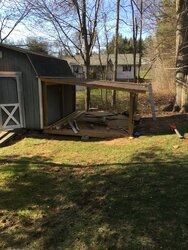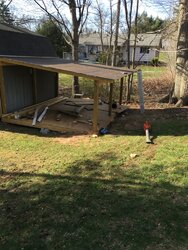Work in progress
- Thread starter prezes13
- Start date
-
Active since 1995, Hearth.com is THE place on the internet for free information and advice about wood stoves, pellet stoves and other energy saving equipment.
We strive to provide opinions, articles, discussions and history related to Hearth Products and in a more general sense, energy issues.
We promote the EFFICIENT, RESPONSIBLE, CLEAN and SAFE use of all fuels, whether renewable or fossil.
You are using an out of date browser. It may not display this or other websites correctly.
You should upgrade or use an alternative browser.
You should upgrade or use an alternative browser.
- Status
- Not open for further replies.
Lone_Gun
Member
Nice work on the wood shed! It will be nice to have your wood under cover!
Sent from my iPad using Tapatalk
Sent from my iPad using Tapatalk
HisTreeNut
Minister of Fire
English BoB
Minister of Fire
View attachment 178038 View attachment 178037 So I finally got to built my wood shed. It's 10'x12' I think it should hold anywhere 4 to 4,5 cords. So two years worth of wood for me. Still have to do the walls and shingle the roof. So far two days worth of work.
Thats a nice extension, but arnt those roof panels going the wrong way ?
bob
I don't know, it's my first build. Each plywood is nailed to a 2x4. I hope I did it right...Thats a nice extension, but arnt those roof panels going the wrong way ?
bob
AmbDrvr253
Minister of Fire
Thats a nice extension, but arnt those roof panels going the wrong way ?
bob
As long as they are overlapped they should be fine. That is if the first one was layed from the opening and toward the shed.
sportbikerider78
Minister of Fire
I think you are really going to hate that the floor is not even when you start stacking wood.
What is the advantage of taking it off the drip edge of the shed? I'd think about just extending the roof up so that you can stand. My back and neck are hurting thinking about carrying wood huddled over on an uneven floor with the roof so low.
What is the advantage of taking it off the drip edge of the shed? I'd think about just extending the roof up so that you can stand. My back and neck are hurting thinking about carrying wood huddled over on an uneven floor with the roof so low.
No it's all leveled it just looks like that because of the sloped ground. There is really no advantage. I was trying to blend it in. The lowest part of the shed is about 4.5'. I wasn't planing on making it 10' wide. But then instead buying 5' lumber I did 10'.
WASP
Member
The thing about building stuff is, you'll soon learn what you like and don't like. It's a learning experience and you can change things in the future.
I'm not sure I understand the statement of "overlapping" when it comes to the roof. Have you roofed it yet of just put plywood up there?
I'm not sure I understand the statement of "overlapping" when it comes to the roof. Have you roofed it yet of just put plywood up there?
WASP
Member
therdlesstravld
Member
Im sorry in advance because people usually don't like criticism. That said it is a very low pitch roof and a long span for the size lumber you used. The snow weight is going to be tremendous in Connecticut and Id be really careful about it collapsing.
It's also low enough of a pitch that you'd really need to use a rubber roof. That's nr such a big deal since it's just for wood but it could possibly leak being that low of a pitch and not being rubber.
It's also low enough of a pitch that you'd really need to use a rubber roof. That's nr such a big deal since it's just for wood but it could possibly leak being that low of a pitch and not being rubber.
- Pitch is low. I used the paper and I shingled so I am hoping that's enough. As far as support I am thinking about supporting it in the middle. I am not a carpenter and it is my first build. I hope not a last one. And believe me I don't mind a constructive criticism that's how you learn.
therdlesstravld
Member
Just be careful in a snowstorm. If you get a heavy wet snow you might want to remove it before it piled up too much.
- Pitch is low. I used the paper and I shingled so I am hoping that's enough. As far as support I am thinking about supporting it in the middle. I am not a carpenter and it is my first build. I hope not a last one. And believe me I don't mind a constructive criticism that's how you learn.
If you are going to add support find the midline of your span and put something like a doubled up 2x10 running across the underside of the joists vertically. Support it on both sides with 4x4s and you'll add a whole lot of structure to it. Use some metal brackets to attach the joists to the beam and you'll be set.
therdlesstravld
Member
Damn j just went back and looked at your pictures again. The posts that you have on the low side lf the lean to, you have a ledger board running across that all the joist ends sit on. Are those posts under the ledger board or did you just nail that board to the posts and then sit the joists on top? If so you really need to redo it. It's not the end of the world and i don't mind helping you figure it out but the snow load will destroy it if you didn't put the posts under the ledger.
Ledger board is nailed to the posts. But I was wise enough to use metal brackets and screw everything together. Believe it or not but it seems to be very stable. But I am not a carpenter or engineer so I might be wrong.
therdlesstravld
Member
Hey it's not how I would do it but if your happy with it who am I to say otherwise! Just keep an eye on those nail connections when it's under snow load to get an idea of it's ok or not.
To avoid future mistakes how was I supposed to install the ledger board? I might be building another one so I want to learn as much as I can now so I can avoid mistakes later.
therdlesstravld
Member
You want anything that's being supported to translate the weight strsight downward to something solid, that's called a point load. So what you would do in this case is if you have a 2x8 say as your ledger and a 4x4 as your post. You measure down 7 1/4" from the top of your post and in 1 1/2" and remove that section. It gives a pocket for the 2x8 to sit in and then you place the ledger in that pocket and nail it all together really well.
This takes the strain off of the nails and puts it on the seat cut of the post. Now if you were placing a doubled up ledger board on a 4x4 (it's almost as thick as a 4x4) then you would put the post under the beam and use brackets or a helluva lot of toe nails to attach it.
This takes the strain off of the nails and puts it on the seat cut of the post. Now if you were placing a doubled up ledger board on a 4x4 (it's almost as thick as a 4x4) then you would put the post under the beam and use brackets or a helluva lot of toe nails to attach it.
Yes makes sense. Should have thought about it. My only hope is that since I used metal brackets with screws it will hold, if not it's going to be an expensive lesson.
Oldman47
Minister of Fire
The shear strength of screws sort of sucks. As far as strength you would be better off using joist hanger nails to hold up the joist hangers. The strength of a screw is really only the strength of the solid center part, inside the screw threads, so it is pretty low compared to a nail of the same diameter. When you attach a joist hanger you use the pre-drilled holes for attachments so the overall diameter is limited and screws are a last choice. First choice is a hanger nail made for that diameter hole, second would be an ordinary nail that will fit and last choice is a screw.
The above discussion about using the strength of the wood support rather than the fasteners is a good one. When I do that I tend to overkill by using carriage bolts to hold the pieces to each other.
The above discussion about using the strength of the wood support rather than the fasteners is a good one. When I do that I tend to overkill by using carriage bolts to hold the pieces to each other.
Next I have to put all my wood in and start working on more.
- Status
- Not open for further replies.
Similar threads
- Replies
- 10
- Views
- 686
- Replies
- 20
- Views
- 2K
- Replies
- 28
- Views
- 2K



